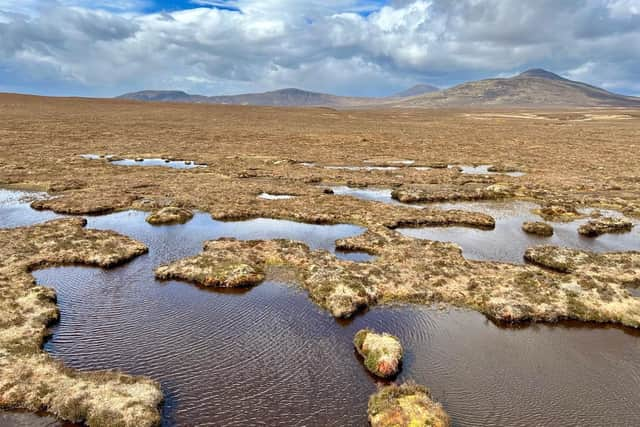Flow Country Scotland: Peatland restoration could generate £400m for northern Highlands within 20 years
Restoring peatlands in the Flow Country could be worth £400 million to the local area over the next 18 years, a new report has shown.
It has also been revealed up to £4.2 billion could be brought in over the coming century through the sale of carbon credits.
Advertisement
Hide AdAdvertisement
Hide AdHowever, crofters and others who manage land are nervous of or opposed to trading the environmental stocks.
The findings come from a new report measuring the economic impact and business potential of bringing damaged peatlands in Caithness and Sutherland’s Flow Country – Scotland’s peat capital – back to a healthy condition.
Large-scale repair work could benefit both the environment and local communities, the study found. Peat bogs are important sinks for climate-warming carbon dioxide, storing twice as much as all the world’s forests.
Healthy peatlands also provide important natural services, boosting biodiversity, improving water quality and helping to prevent flooding, droughts and wildfires.


Scotland hosts vast areas of these wetland eco-systems, with around a fifth of the entire landmass carpeted in peat soils. The northern Highlands region is home to the largest expanse of blanket bog in Europe and 5 per cent of the global total, storing an estimated 400 million tonnes of carbon.
The rare habitat stretches across around 400,000 hectares of Caithness and Sutherland, named the Flow Country, and is being considered by Unesco for World Heritage Site status. But an estimated 180,000 hectares, almost half of the bog area, is thought to be degraded and in need of rehabilitation.
Ramping up peatland restoration in Loch Lomond and the Trossachs – Scotland’s original national park
Analysis suggests that carrying out this work could have significant economic boons for the region, creating nearly 300 jobs, while also supporting sectors such as whisky and fishing, which are reliant on peat and creating opportunities for spin-off businesses in tourism, education and research.


The Scottish Government has pledged to spend £250 million on peatland restoration between 2020 and 2030, with an aim to fix 25,000 hectares each year. The funding pays for measures such as blocking drainage, installing small dams and other interventions to stop the bogs from drying out.
Advertisement
Hide AdAdvertisement
Hide AdBut work is not going fast enough, with less than 6,000 hectares restored in each of 2021 and 2022 – way short of the annual target.
The report, commissioned by the Flow Country Partnership and North Highland Initiative (NHI), highlights barriers to achieving the goals, including a shortage of skilled workers, high machinery costs, complicated tendering processes and poor communications. Bad weather and other environmental snags also hamper progress.
The report suggests solutions for some of the problems and stresses the importance of pilot projects for testing how best to carry out restoration.
“It is hard to understate the importance of the uniquely valuable and vulnerable qualities of Flow Country,” said Genevieve Duhigg, chair of NHI.
“Its preservation and responsible management is crucial to the success of so many endangered species, whilst developing opportunities for the people who live and work here is vital to the success of rural communities. Above all, restoring and preserving this hugely important carbon sink is crucial to preventing climate change.
“This approach presents an opportunity to balance these factors in a sustainable way.”
The report was undertaken by 4c Engineering, with support from NatureScot, Highlands and Islands Enterprise and others.
Comments
Want to join the conversation? Please or to comment on this article.